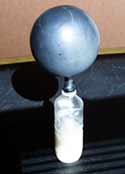|


The
purpose of any leavener is to produce the gas that makes bread
rise. Yeast does this by feeding on the sugars in flour, and
expelling carbon dioxide in the process.
While
there are about 160 known species of yeast,
Saccharomyces
cerevisiae,
commonly known as baker's yeast, is the one
most often used in the kitchen. Yeast is tiny: Just one gram
holds about 25 billion cells. That amount of fungi can churn
out a significant amount of carbon dioxide, provided it has
the simple sugars it uses as food. Fortunately, yeast can
use its own enzymes to break down more complex sugars—like
the granulated sugar in the activity below—into a form
that it can consume.
Make
a yeast-air balloon to get a better idea of what yeast can
do.
Recipe
Conversions
|
 CAUTION
CAUTION
Kids, please don’t try this at home without the help
of an adult.
 Did
You Know?
Did
You Know?
Yeast
also produces alcohol as it feeds, which is why it is an important
ingredient in making beer.
 Did
You Know?
Did
You Know?
In
1857, Louis Pasteur discovered that yeast is a living organism
whose activity causes fermentation.
|
|
As the yeast feeds on the sugar, it produces carbon dioxide.
With no place to go but up, this gas slowly fills the balloon.
A
very similar process happens as bread rises. Carbon dioxide
from yeast fills thousands of balloonlike bubbles in the dough.
Once the bread has baked, this is what gives the loaf its
airy texture.
|
|
|
Try the same experiment, but this time use about a tablespoon
of baking powder instead of yeast, and leave out the sugar.
What differences do you notice? Which leavener takes longer
to fill up the balloon?
Also,
try the same experiment using hotter and colder water. Use
a thermometer to measure the temperature of the water. At
what temperature is the yeast most active? At what temperatures
is it unable to blow up the balloon? Compare your results
to this
chart
.
|
